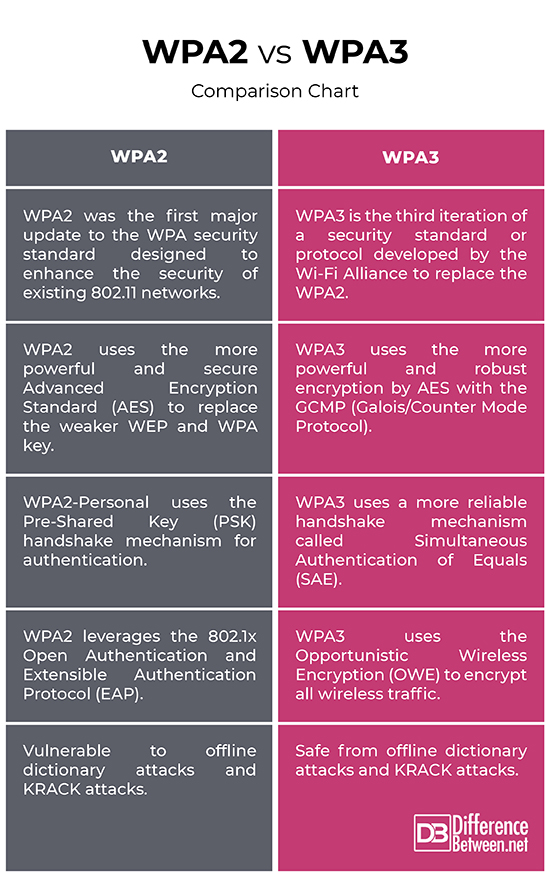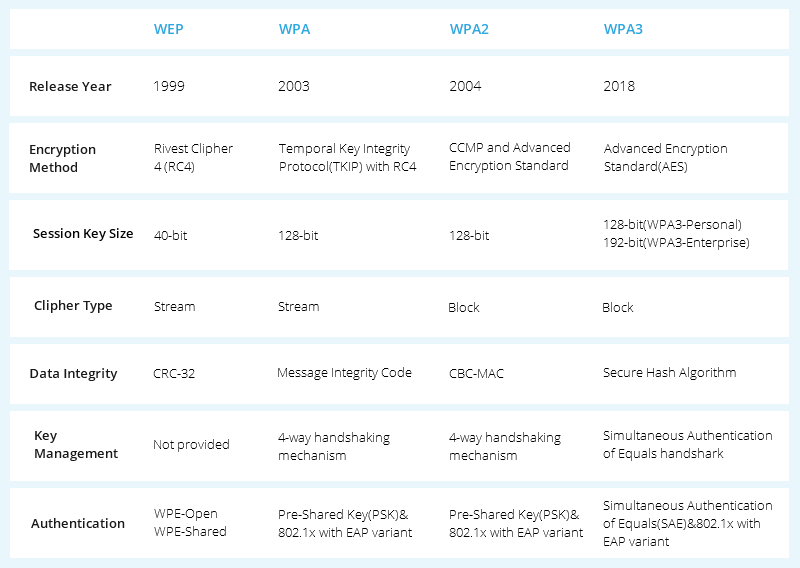Which Is Safer WPA2 Or WPA3?
WPA2 and WPA3 are two different wireless security protocols used to protect Wi-Fi networks. Both protocols are designed to provide strong encryption and authentication, ensuring that data sent over the airwaves is secure and only accessible by authorized users. WPA2 has been the standard for many years, while WPA3 was released in 2018 and offers improved security features. So, which one is safer? Both protocols offer strong security, but WPA3 offers some extra features that make it more secure than WPA2. WPA3 includes improved encryption, robust authentication, and additional protections against brute-force attacks. As such, WPA3 is considered the safer of the two protocols and is recommended for use when setting up a new Wi-Fi network.
Overview of WPA2 and WPA3
Security Protocols
When it comes to cyber security, it is essential to be aware of the different security protocols available. WPA2 and WPA3 are two of the most commonly used security protocols for wireless networks, but there are distinct differences between the two. To help make sure your network is secure, it is important to understand the differences between WPA2 and WPA3.
WPA2, or Wi-Fi Protected Access 2, was the first security protocol to be widely used and has been around since 2004. The protocol utilizes a pre-shared key (PSK) to encrypt data sent over a wireless network. WPA2 is still widely used but is no longer considered as secure as it was when first introduced.
WPA3, or Wi-Fi Protected Access 3, was released in 2018 and is the latest security protocol. It provides a much higher level of security than WPA2 as it uses a much more complex encryption algorithm. WPA3 also uses a stronger authentication protocol, called “Opportunistic Wireless Encryption (OWE),” which makes it virtually impossible for an attacker to access the network.
When it comes to security protocols, it is important to choose the one that is best suited for your needs. WPA2 is still a viable option for many users, but if you want the highest level of security, then WPA3 is the way to go.
Comparison of WPA2 and WPA3
When it comes to securing your home network, you want to make sure you’re using the best and most secure options available. Two of the most popular wireless security protocols are WPA2 and WPA3. Both are used to protect your network from intruders, but which one is safer? To help you decide, we’ll compare the two and explore their differences.
WPA2 is an older protocol that has been around since 2004. It has a number of security features, including encryption, authentication, and access control. However, it is vulnerable to certain types of attacks, such as the KRACK attack. WPA3 is the latest wireless security protocol, released in 2018. It offers enhanced security features such as improved encryption, authentication, and access control. It is also more resistant to attacks like the KRACK attack.
When it comes to safety, WPA3 is considered to be the more secure option. It has better encryption and authentication and is more resistant to certain types of attacks. It also offers additional features such as forward secrecy, which makes it harder for attackers to decrypt messages sent over the network. However, WPA2 is still a viable option for many users, as it is widely supported and is still considered secure.
Ultimately, the choice between WPA2 and WPA3 will depend on your specific needs. If you’re looking for the most secure option, WPA3 is the way to go. However, if you need compatibility with older devices, WPA2 may be the better choice. Whichever you choose, make sure to use strong passwords and other security measures to ensure your network’s safety.
Advantages and Disadvantages of WPA2
and WPA3
Wireless Protection Access (WPA) is a security protocol used to protect Wi-Fi networks. In recent years, the two most popular protocols, WPA2 and WPA3, have been developed to provide improved security for wireless networks. But which of these two protocols is the most secure? To answer this question, it is important to understand the advantages and disadvantages of WPA2 and WPA3.
WPA2 is the most widely used Wi-Fi security protocol. It is a strong protocol with encryption and authentication capabilities that enable users to securely connect to a network. However, there have been several reported vulnerabilities in WPA2, including the KRACK attack, which can allow an attacker to intercept data on a WPA2-protected network.
WPA3 is the latest Wi-Fi security protocol and provides improved security for networks. It offers stronger encryption, better authentication, and improved security against brute-force attacks. It also offers improved protection against side-channel attacks such as the KRACK attack as well as better protection against dictionary attacks. However, some devices may not support WPA3, so it is important to check with the manufacturer before upgrading.
Ultimately, both WPA2 and WPA3 provide robust security for wireless networks. However, WPA3 provides improved security and is the most secure protocol available. For users who are looking for the best security, WPA3 is the best choice.

Advantages and Disadvantages of WPA3
As technology advances, so do the security protocols used to protect our data. Wi-Fi Protected Access (WPA) is a security protocol used to protect wireless networks. It has gone through several iterations, with the latest version being WPA3. This protocol provides improved security features compared to its predecessor, WPA2. But what are the advantages and disadvantages of WPA3?
The first advantage of WPA3 is its improved encryption. WPA3 utilizes stronger encryption algorithms than WPA2, making it more difficult for attackers to decrypt the data traveling through the wireless network. It also provides better protection against brute-force attacks, as well as improved user authentication methods. In addition, WPA3 supports the latest encryption standard, called Simultaneous Authentication of Equals (SAE). This provides better protection against dictionary attacks.
However, there are some disadvantages to WPA3. It is not backward compatible with WPA2, meaning that all devices must be updated in order to use the new protocol. Additionally, WPA3 requires specialized hardware, which can be costly. Finally, WPA3 is not yet widely adopted, so it may not be available on some networks.
Overall, WPA3 offers improved security features compared to its predecessor, WPA2. However, it is important to weigh the advantages and disadvantages of WPA3 before deciding to upgrade.
Recommendations for Choosing Between WPA2 and WPA3
It’s essential to choose the right Wi-Fi security protocol for your home or business, and two of the most popular options are WPA2 and WPA3. Each protocol has its own advantages and disadvantages, and understanding the differences between the two is essential for making an informed decision. WPA2 is the older protocol, and while it is still widely used, it has some security vulnerabilities. WPA3 is the latest protocol and offers enhanced security, but it is not compatible with all devices. In this article, we will discuss the differences between WPA2 and WPA3 and provide recommendations for choosing between the two.
When it comes to security, WPA3 is the clear winner. It provides improved encryption, secure key exchange, and secure authentication. WPA3 also eliminates the risk of brute-force attacks and makes it more difficult for attackers to intercept your traffic. The downside is that it is not compatible with older devices, and it is not yet widely available.
WPA2 is the more established protocol and is compatible with most devices. It is still considered secure, but it has some known vulnerabilities. It is also vulnerable to brute force attacks and is not as secure as WPA3.
Ultimately, the choice between WPA2 and WPA3 depends on your security needs. If you have an older device or need to support multiple devices, WPA2 is the better option. If you are looking for an extra layer of security, WPA3 is the way to go. Both protocols are secure, but WPA3 offers the most advanced security features. Whichever protocol you choose, make sure to use a strong password and enable additional security features to ensure your network is as secure as possible.
Conclusion
When it comes to wireless network security, there are a few options out there. WPA2 and WPA3 are two of the most popular, and both offer significant improvements in the way that Wi-Fi networks are secured. WPA2 is the older protocol and is still widely used, however, WPA3 is the newer and more secure option.
Overall, WPA3 offers more robust security, with features like individualized data encryption, stronger authentication protocols, and more secure key management. However, it is important to note that WPA3 is not yet widely supported, as it is still relatively new. Additionally, it is important to note that WPA2 is still a very secure protocol and is still widely used.
Ultimately, the decision between WPA2 and WPA3 is up to the individual user. It is important to do the research and determine which protocol is best for your particular network. WPA3 is the newer and more secure option, but WPA2 is still a very secure protocol and is still widely used. Ultimately, you should make the decision based on your own needs and requirements.
FAQs About the Which Is Safer WPA2 Or WPA3?
1. What is the difference between WPA2 and WPA3?
Answer: WPA2 is the predecessor to WPA3 and is a wireless security protocol that provides authentication and encryption of data sent over wireless networks. WPA3 is the latest version of the WPA protocol and provides additional security features such as enhanced authentication and encryption methods.
2. Is WPA3 more secure than WPA2?
Answer: Yes, WPA3 is more secure than WPA2. WPA3 offers improved security features such as enhanced encryption and authentication methods as well as additional protections against brute force attacks and other security vulnerabilities.
3. Does WPA3 work with older devices?
Answer: Yes, WPA3 is backwards compatible with WPA2 and is able to work with older devices. However, devices that do not support the new security features of WPA3 will not be able to take advantage of the enhanced security that the protocol provides.
Conclusion
Overall, WPA3 is the safer option compared to WPA2. WPA3 has stronger encryption methods that can better secure wireless networks and protect against brute-force attacks. It also adds a key rotation feature which makes it harder for hackers to gain access. WPA3 also adds additional features such as improved password-based authentication and reduced vulnerability to dictionary attacks. Therefore, WPA3 is the better and safer option when it comes to securing wireless networks.




